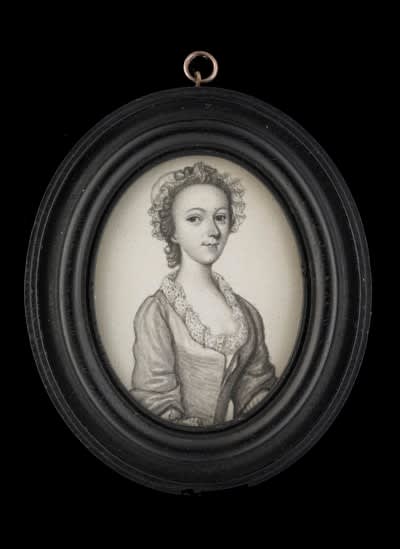
James Ferguson
Portrait drawing of a Lady, wearing figured dress with lace collar and lace cap, c. 1750
Ink and wash on paper
Oval, 2 1/in (54mm) high
Philip Mould & Co.
To view all current artworks for sale visit philipmould.com James Ferguson came from a humble background, where his education was almost non-existent. After teaching himself to read, his father...
To view all current artworks for sale visit philipmould.com
James Ferguson came from a humble background, where his education was almost non-existent. After teaching himself to read, his father agreed to send him to school where his aptitude was noted and he subsequently attended the local grammar school.
Ferguson’s earliest interests were rooted in science and mathematics. When he watched his father, a farmer, using a lever to raise the decayed roof of the family smallholding, he wrote an account of the principle of mechanical advantage. At night, working as a shepherd, he studied the stars. At the age of fourteen, a local farmer encouraged this interest, aiding him to chart the star’s positions. A local gentleman, Thomas Grant, also encouraged Ferguson’s curiosity and talent, offering him a position in his household where he could be taught by Alexander Cantley, his butler. When Cantley moved away, Ferguson was again left to his own devices and made himself a globe at home, subsequently fashioning a watch using a whalebone spring and a clock from wood.
Ferguson first became acquainted with drawing whilst working for Sir James Dunbar of Durn at the age of about twenty-three. He was employed by Durn to maintain his clocks but also showed some skill in copying his paintings. William Baird, a relation of Sir James’s, invited him to use his library and taught him how to use Indian ink. Baird was subsequently his first portrait subject. Encouraged by this excellent start to his painting career, Ferguson moved to Edinburgh to seek an apprenticeship with an oil painter.
He was, however, distracted by a desire to study anatomy and surgery and began training and practising as a doctor. He also rekindled his interest in astronomy, in which he began lecturing after introducing himself to Professor Colin Maclaurin.
Ferguson once again began painting as a way of providing the funds to become a mathematics teacher. He worked in London from 1743, taking on as many commissions as he could manage. During this time he continued to lecture and began to publish.
He was made a fellow of Royal Society in 1763 and continued to publish. His work was greatly valued and George III granted him a pension of £50 per annum from 1761. When he died in London in 1776 he left a considerable estate.
James Ferguson came from a humble background, where his education was almost non-existent. After teaching himself to read, his father agreed to send him to school where his aptitude was noted and he subsequently attended the local grammar school.
Ferguson’s earliest interests were rooted in science and mathematics. When he watched his father, a farmer, using a lever to raise the decayed roof of the family smallholding, he wrote an account of the principle of mechanical advantage. At night, working as a shepherd, he studied the stars. At the age of fourteen, a local farmer encouraged this interest, aiding him to chart the star’s positions. A local gentleman, Thomas Grant, also encouraged Ferguson’s curiosity and talent, offering him a position in his household where he could be taught by Alexander Cantley, his butler. When Cantley moved away, Ferguson was again left to his own devices and made himself a globe at home, subsequently fashioning a watch using a whalebone spring and a clock from wood.
Ferguson first became acquainted with drawing whilst working for Sir James Dunbar of Durn at the age of about twenty-three. He was employed by Durn to maintain his clocks but also showed some skill in copying his paintings. William Baird, a relation of Sir James’s, invited him to use his library and taught him how to use Indian ink. Baird was subsequently his first portrait subject. Encouraged by this excellent start to his painting career, Ferguson moved to Edinburgh to seek an apprenticeship with an oil painter.
He was, however, distracted by a desire to study anatomy and surgery and began training and practising as a doctor. He also rekindled his interest in astronomy, in which he began lecturing after introducing himself to Professor Colin Maclaurin.
Ferguson once again began painting as a way of providing the funds to become a mathematics teacher. He worked in London from 1743, taking on as many commissions as he could manage. During this time he continued to lecture and began to publish.
He was made a fellow of Royal Society in 1763 and continued to publish. His work was greatly valued and George III granted him a pension of £50 per annum from 1761. When he died in London in 1776 he left a considerable estate.
3
of
3